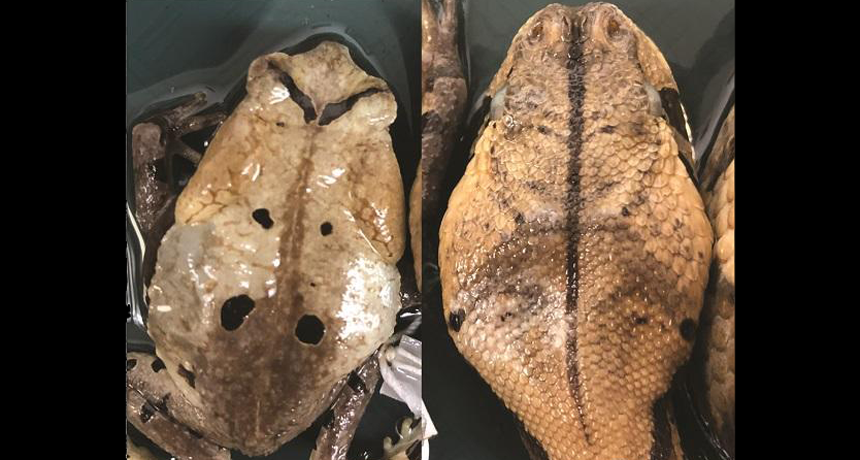Congolese toads may avoid predators by copycatting deadly vipers
It looks like the first case of a frog or toad mimicking the look and hiss of a venomous snake

With its lookalike body and hiss, the Congolese giant toad (left) appears to be mimicking the Gaboon viper (one shown, right) that shares its territory.
Eli Greenbaum
Congolese giant toads might be giving predators the slip by taking on the look and sound of venomous vipers. The cheeseburger-sized African toads appear to be using this fakeout to avoid becoming another animals’ lunch.
Toads are actually a type of frog, explains Eli Greenbaum, who works at the University of Texas at El Paso. So this would be the first example of a frog imitating a venomous snake. As a herpetologist, he studies amphibians and reptiles.
The Gaboon viper (Bitis gabonica) is one of the largest in Africa. It sports roughly 5-centimeter (2-inch) fangs. They’re “the longest fangs of any snake in the world,” Greenbaum says. Their venom isn’t super toxic. But the snake can inject enough of its toxin to make it deadly, he says.
A member of his research team noticed an uncanny resemblance between her pet Gaboon viper and a photo of the top of a giant toad. That toad was known as Sclerophyrs channgi, Greenbaum recalls. So the scientists sized up and studied the color patterns of 10 vipers and 16 of these toads in museum collections.
A color pattern on the toad’s body resembles the viper’s head. The toad also is similar in size to the viper’s head. By raising its rump, this toad “shows off this color pattern and shape that looks kind of like the cocked head of a Gaboon viper that’s preparing to strike,” Greenbaum says. And when handled, the toad makes a noise like a balloon letting out air. This sounds like the viper’s wheezy hiss.
His team reported its observation October 20 in the Journal of Natural History.
Found in the Democratic Republic of Congo, these toads have so far shown up only in places where the viper also lives. Other scientists have analyzed the DNA of both the viper and toad. The ancestors of both species seem to have emerged between four million and five million years ago. They may have evolved together, notes Greenbaum, who is also an evolutionary geneticist. Such scientists look at DNA to understand how organisms evolved.
So far, this makes “a pretty strong case that these toads are mimicking these vipers,” Greenbaum says. But proving it would require testing if would-be toad eaters are actually duped.
An imitation game?
That observation is “exciting because the frog really looks like the head [of the viper],” says Jindřich Brejcha. An evolutionary biologist, he studies how diverse lifeforms evolve over time. Brejcha, who did not take part in the new study, works at Charles University and the National Museum. Both are in Prague, the capital of the Czech Republic.
We can’t be sure predators see the toads as we do, Brejcha says. Some predators may be able to see light outside of the range of wavelengths that human eyes pick up. Birds, for instance, can see some ultraviolet light that people can’t. So the scientists might want to measure the color of both animals to see if they are actually the same. The researchers also could run experiments to see whether predators avoid the toads or fake versions in tests.
Since very little is known about the toad, it’s not clear what predators it might be trying to fool. “This is the most important piece in this puzzle,” says Johanna Mappes. She, too, is an evolutionary biologist and was not part of the study. Mappes works for the University of Jyväskylä in Finland. (She’s currently based in Berlin, Germany.) Because the toads seem to coopt the viper’s sound, Mappes is curious whether predators respond to the toad’s sound as they do to the viper’s hiss.
Humans and monkeys are really afraid of the snakes, Mappes says. But some birds of prey are superb snake killers. They may not fear the vipers. She says “that’s why many snakes, even if they are very venomous … they don’t advertise themselves.” So even if the toads are copycats, the vipers might be trying to blend in. Their colors look a lot like the leaf litter where they wait to ambush prey.
Such mimicry doesn’t have to be perfect for it to help a beefy toad stay out of snack territory. “The more venomous or scary the [imitated animal], the easier it is to mimic,” Mappes says. Even a vague resemblance might do the trick, because predators don’t want to take a risk.







